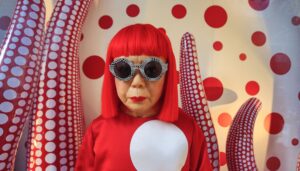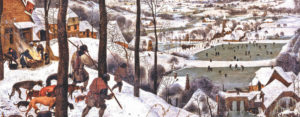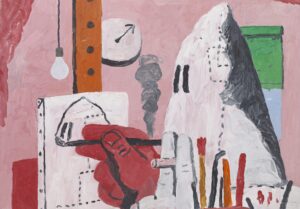Slightly bedraggled, a Royal British Legion poppy wreath hangs on the railings outside Museum Arnhem. In the pretty sculpture garden that overlooks the Rhine as it flows into the Netherlands from Germany stands a monument to the soldiers of the South Staffordshire regiment who, in September 1944, fell on and around this spot during the Battle of Arnhem: the ill-starred “Operation Market Garden”. Down in the city centre, by the riverbank, a memorial site commemorates the thwarted British attempt to seize the Rhine crossing at the “bridge too far”, push quickly into Germany, and so speedily terminate the European war. A bigger museum upstream at Oosterbeek memorably restages the valour, and horror, of this final large-scale defeat for wartime British forces. Whatever its still-disputed causes, Market Garden’s overall failure (although Para commander John Frost held the bridge whose replacement now bears his name) arguably cost hundreds of thousands of lives over the bitter winter months to come.
You have to wonder what the men of the South Staffs, the 1st Airborne Division and their Polish comrades would make of Museum Arnhem’s current exhibition. No colourful banners announce it outside the galleries. No posters adorn the walls in town. Discretion rules: you have to know to go. Inside, however, half-a-dozen rooms gather the German state-approved art of 1933-45 into an exhibition entitled Art in the Third Reich: Seduction and Distraction. Conceived by the museum’s director of modern art, Jelle Bouwhuis, with co-curator Almar Seinen and an international scholarly team, the Arnhem show covers the spectrum of regime-friendly painting and sculpture that Adolf Hitler and the Nazi leadership not only endorsed and promoted but in many cases bought. Bouwhuis makes it clear that “We do not ‘simply’ show the work, we contextualise it,” to explain “how art and… the whole art world in Germany could function as propaganda for Nazism”.
Amid this welter of craggy warriors, apple-cheeked peasants, chocolate-box landscapes and cheesily curvaceous nudes, the suffering and slaughter inflicted by the Reich — not least around this very building — seem a million miles away. The curators have shunned overt propaganda images: no worshipful portraits of the Führer himself (although he does feature in a couple of monumental canvases), let alone antisemitic caricatures or sub-human Slavs. Rather, the rooms take us on a journey through the fantasy Third Reich of cheerful land-workers, grandiose infrastructure projects, pristine German scenery, Völkish mythology, and mighty deeds in combat with the foe. I went expecting, or fearing, a grotesque assemblage of bombastic kitsch, and with lingering doubts about whether such an exhibition has a place in a public gallery — even now, especially here.
Well, kitsch there is aplenty. But Arnhem’s tour of National Socialism’s politicised aesthetics also posed a more profound question about how creative powers survive, or shrivel, under any oppressive orthodoxy. Was this a show too far? Thanks to the sober intelligence of its curation, not at all. The Dutch still take free debate and enquiry in earnest. It’s hard to imagine that any UK gallery or museum could present such a treasury of taboo items today without a career-threatening storm of fury and denunciation. And for years the toxic associations of this material meant that post-war museums kept it firmly out of sight. US forces seized around 8,000 works of art from Germany after the war, but later returned all but a few hundred deemed inflammatory — such as idealised celebrations of Hitler. Much of this repatriated booty now resides at the Deutsches Historisches Museum in Berlin, the chief lender for the Arnhem show. Until very recently, few institutions have cared to borrow it.
Instead, they have historically trained a spotlight not on the work the Nazis loved, but that they loathed — and banned. Seized from artists, collectors and galleries, the so-called “Degenerate Art” of Cubism, Expressionism, Surrealism and related modernist trends filled a notorious regime-sponsored show of 1937 in Munich, which later toured Germany. Two million visitors came to gawp and sneer (although many might have secretly enjoyed what they saw). Starting with the Los Angeles County Museum in 1991, contemporary curators have since tried to reconstruct the “Entartete Kunst” displays, but with the poles of judgment neatly reversed. Works by Klee, Mondrian, Chagall, Ernst, Kandinsky and a host of others, ridiculed and censured under the Reich as savage, decadent and barbarous, came to figure as sacred icons of 20th-century creativity. The Nazi curse blessed these artists’ future prospects in both the critical and commercial marketplaces.
To post-war art lovers in Europe and North America, abstraction and other non-figurative styles now mean freedom, individuality, the defiance of dictatorship. In contrast, the neo-classical, representational or simply traditional modes of painting that dominate the rooms at Arnhem found themselves branded with the taint of tyranny. Even before the Second World War, the advocacy of such taste-makers as Alfred Barr — director of New York’s Museum of Modern Art — for “decadent” artists persecuted under the Reich had helped to shift the dial. When President Roosevelt opened the new MoMA building in 1939, he proclaimed that if you “Crush individuality in society… you crush art as well.”
Non-realist styles now bask in the glow not just of cultural progress but political virtue as well. The Cold War entrenched this orthodoxy, as US Abstract Expressionism became an anti-Soviet propaganda weapon for the CIA. Much of Western academia still obediently reproduces it. Yet figurative painting thrived in many places over the postwar decades without any sign of contamination by either Nazi or Soviet ideology. One glance at the British scene, with representational giants as different as Lucian Freud, David Hockney and Paula Rego, underlines the absurdity of the Modernist dogma that made, say, any lifelike portrait into a “reactionary” act. That is theology, not criticism.
The artists displayed at Museum Arnhem, who all showed and sold in Germany during the period between 1933 and 1945, had no choice but to work in a broadly realist manner. Not just abstraction but the subjective visions of the Expressionists spelled subversion (with a Jewish, Bolshevik or “Negro” character) to the arbiters and enforcers of the Reich. Now, technical proficiency should serve traditionalist topics — country life, family scenes, classical nudes, martial glory, Germanic and Nordic myths and histories — to celebrate the mission of the nation and its Führer. For artists who worked in the approved idioms and were untainted by Jewish ancestry, active Left-wing loyalties or a known attachment to “decadent” styles, the rewards might prove lavish. Conformity could pay handsomely.
Official art under the Nazis was big business. Most of the Arnhem pieces featured in one of the eight Great German Art exhibitions held at the pharaonic new “House of German Art” in Munich from 1937 to 1944. At its height, in 1942, it attracted 847,000 visitors, and 2,500 out of around 14,000 registered artists in Germany exhibited there. The Great German Art jamborees also functioned as selling shows, with the Nazi top brass among the top buyers. Hitler himself acquired scores of works, such as the chillingly monumental symbolic nudes of Adolf Ziegler’s “The Four Elements”, which greets visitors at Arnhem. The Führer spent an estimated 6.9 million Reichsmarks on his art shopping.
Bouwhuis reports that the sheer scope of the sector surprised him: “It was a real hype, with huge financial investments especially from the government, a thriving art scene and many opportunities for artists.” And the breadth of Nazi patronage opened a lucrative career path to some truly terrible lickspittle hacks. I hope never again to inspect anything by, say, Leopold Schmutzler, whose trio of joyful accordion-playing maidens in “Return from the Fields” recall the similar bucolic schmaltz of “Socialist Realism” in Stalin’s USSR. As for those plentiful Nazi nudes, churned out in bulk by Nazi court painters such as Ivo Saliger and Oskar Martin-Amorbach, their skin tones glow with a peculiar brand of semi-pornographic deathliness. Beefy but ghastly, these eugenic pin-ups lead the viewer on — and lead us, it somehow feels, straight into the grave. A few, though, have become simply risible. The musclebound labourers of Albrecht Kettler’s “Organisation Todt” now look like a National Socialist bid to out-hunk gay porn of the “Tom of Finland” kind.
But to tour the Arnhem galleries in order to scoff at one gross Aryan fantasy after another would merely turn the Nazis’ own “Degenerate Art” polemic on its head. What will haunt the visitor is the evidence of the able, even gifted, painters who went on working in officially blessed styles under a totalitarian regime. Did compromise and caution vitiate their talents, or might they keep a guttering flame of integrity alight? Bouwhuis suggests that artists who kept out of trouble under the Reich had more options than their Soviet counterparts, with a competitive market and “relatively open-minded” censors in the Reichskulturkammer guild that artists had to join to work.
“This situation”, he explains, “fostered creativity and even a certain deviance, or at least a surprising variation of styles and subjects”. Some of these artists had Modernist and Left-wing hinterlands; several went on to enjoy garlanded post-Nazi careers. Subjugation to the 12-year Reich proved to be an interlude on a journey that started and finished in very different places, aesthetic and political. At least 64 painters and sculptors who had work suppressed in the Nazi purge of “degenerate” art managed to exhibit in the Great German Art shows. In 1937, sculptor Rudolf Belling enjoyed the curious distinction of having works on show in Munich in the “Degenerate Art” sin-bin and the Great German Art hall of fame at the same time. In the studio, the clear dividing-lines in ideologists’ heads might often blur.
Heinrich Ehmsen, for instance, had been a Communist and Modernist with allies in Moscow; he served time in a concentration camp for “cultural Bolshevism”. Yet he later joined a Wehrmacht “propaganda company”: his painting of German troops near Kharkhiv in Ukraine eschews heroics in favour of sombre, almost-abstract, colour bands. On the opposite wall, in contrast, Hans Sterbik’s “Winter War in Poland” transforms a brutal campaign of aggression into a cosy Christmas-card scene. Even under the Reich, artists could choose to admit, or exclude, a measure of truth in their state-endorsed work.
Formalism, and a fascination with the morphology of landscapes, buildings and figures, might have been outlawed in theory. Given the correct topic, it might still sneak back in practice. Erich Mercker, a painterly cheerleader for Hitler’s big-ticket public-works projects, celebrates the futuristic geometries of an Autobahn bridge under construction at Rohrbachbrücke. After the war, he would commemorate the industrial might of firms such as Volkswagen and Bayer. Third Reich art shares this techno-optimism with similar depictions of concrete-and-steel modernity elsewhere — not least in the United States. Faith in the mechanical mastery of nature cut across ideological boundaries.
Not even battlefield scenes inevitably airbrushed military reality out of the picture. Carl Busch’s “Stalingrad”, with its free and fluid brushwork as a German unit makes its last desperate stand in the snow, may depict a heroic defeat — but a defeat nonetheless. Most remarkable at Arnhem are a selection of pieces that somehow paint the artist’s detachment, or even scepticism about the Nazi propaganda industry, into the picture. Several artists here emerged from the cool, crisp and satirical Neue Sachlichkeit — “New Objectivity” — movement of the Weimar Republic. In some cases that piercing, sardonic gaze survives into the Reich: most powerfully, in Adolf Wissel’s “Peasant Family from Kalenberg”. This “ideal” farming clan sits glacially, and spookily, around the family table like actors waiting for a horror film to roll. Rigid and hostile, they seem on the brink of a bloodbath.
As for the uniformed gurning grotesques clustered behind the figure of Hitler in Emil Scheibe’s “The Führer visits the Front”, they are latter-day descendants of Hieronymus Bosch’s human gargoyles. Who would ever have read this piece as a tribute to the victories of the Master Race? In Albert Janesch’s epic “Rhine Crossing at Breisach”, it’s the individually painted faces of the captured French POWs that catch the eye and mind, not the robotic ranks of the German conquerors streaming over the bridge. In front of the defeated French troops, most sympathetically observed of all, stands a West African — likely a Senegalese infantryman.
So, in the city of the “bridge too far”, art in the Third Reich often turns out to be the art created under the yoke of the Third Reich. Several of these painters found freedom of a limited kind as they practised a sort of “inner emigration” while outwardly conforming to the stifling norms enforced by the state. Jelle Bouwhuis reminds me, though, that all these works, however independent or even critical, served a machine of myths and lies within “a pernicious regime that was responsible for some 40 million deaths”. Even the covert dissidents and sly naysayers in their own way fed the Nazi beast. “Ethics and aesthetics”, Bouwhuis insists, “are inextricably attached”. At least Museum Arnhem has given visitors a chance to see, to think, and to judge for themselves. Would that British curators had the audacity to step so far outside their current comfort zones.
‘Art in the Third Reich: Seduction and Distraction’ continues at Museum Arnhem until 24 March 2024: museumarnhem.nl
Disclaimer
Some of the posts we share are controversial and we do not necessarily agree with them in the whole extend. Sometimes we agree with the content or part of it but we do not agree with the narration or language. Nevertheless we find them somehow interesting, valuable and/or informative or we share them, because we strongly believe in freedom of speech, free press and journalism. We strongly encourage you to have a critical approach to all the content, do your own research and analysis to build your own opinion.
We would be glad to have your feedback.
Source: UnHerd Read the original article here: https://unherd.com/




